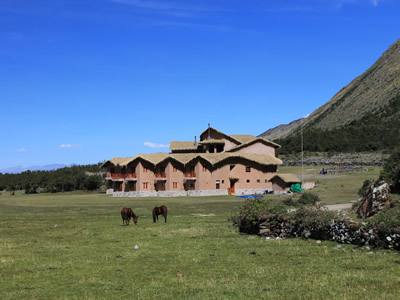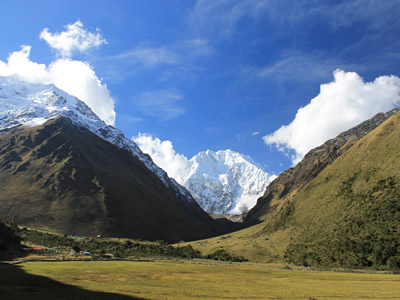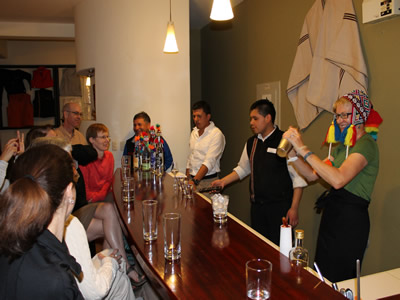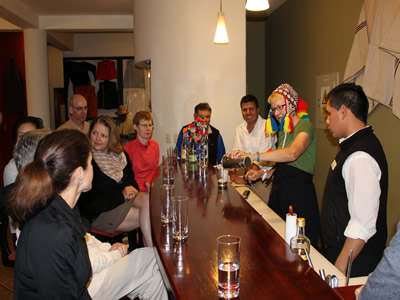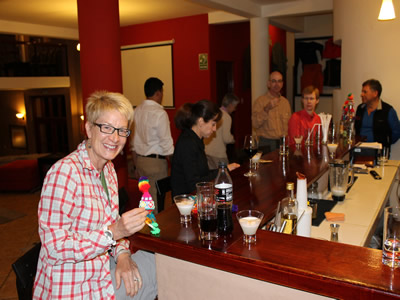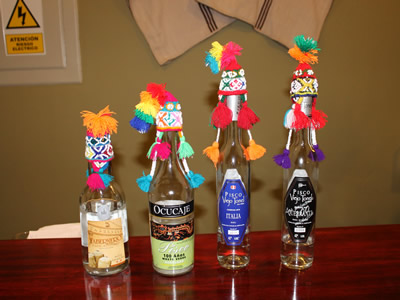Peru - Salkantay Lodge
Our day hike to Humantay Lake had been fantastic. The scenery was great, the weather was beautiful and Sandy and I had no problems with the high altitude. We were back to the lodge by 3 pm. We had a drink to refresh ourselves (I knew to ask for a Coke Zero instead of tea this time) and then showered and changed. The lodges truly were luxurious - they even had a hot tub. Everyone asked about it and Jairo said it would open at 5pm (they had to heat the water). Due to popular demand, he agreed to talk to the lodge folks to see if they would open the hot tub at 4pm.
Although we hadn't tried it the first night, at 4pm Sandy and I were ready to go and were the first ones in the hot tub. We wondered if the water would be hot enough but it felt great. We were soon joined by several people from the other group staying at the lodge. They had hiked up that day and would be doing Humantay Lake the next day. We strongly recommended the hike and gave them a full preview based on our experience.
It was late afternoon and we had a fantastic view of the mountains. I remember leaning back and thinking "I don't think life gets better than this". Almost as soon as I had the thought, I heard Jairo's voice "Would you guys like something to drink?" Yes thank you we would. Jairo sent for the waiter and in a few minutes we all had glasses of wine. I had to admit that Jairo was a genius.
Eventually we got out of the hot tub, got dressed and headed down to the lounge for our group meeting. After a short briefing on the hike for tomorrow, we got to the main subject which was the Pisco Sour, the national drink of Peru. Although Chile still contests ownership, it seems that the Pisco Sour was invented by the American Victor Morris at his bar in Lima in the 1920's. It's a big deal between the two countries and Peru celebrates a national holiday in honor of the drink in February. They asked for volunteers and when no one else spoke up Sandy came forward. She got to wear a special apron and a special hat. Then she got directions for how to make a Pisco Sour from Ivan, the bartender at the lodge. The most important part was shaking it all up after the ingredients had been added. Sandy got a lot of encouragement from the group at this point. Just about everyone gave Sandy's effort a try and most people agreed that it was good. Maybe she is ready to start yet another career as a bartender.
After our lesson in Peruvian drinks we had a chance to do some shopping. Gayla bought a fleece vest with a Mountain Lodges of Peru logo and several other ladies, including Sandy, followed suit. Our friend from the hike who had been playing the flute was also there selling crafts. I bought a really nice wool hat from him as well as some Peruvian minihats to put on wine bottles. These were really cool and I am looking forward to using them at home.
After all the fun in the bar we went upstairs for dinner. The group that had just hiked in today was already there sitting at the next table. I was talking to someone when I saw one of their guys start to slowly lean over and then tumble to the floor. He had not been feeling well and apparently just passed out. After a few minutes he was revived and was taken to his room. He was one of a group of three and both of his companions were also sick. They left soon after without eating any of their dinner. That wasn't a good sign for that group to have so many people sick at the start. A week later in Aquas Calientes one of our party members said that they met someone from this group and learned that everyone had made the trek successfully. It was certainly scary at the time though.
Fortunately for us everyone in our group was feeling well. Tim from California had been sick in the morning so he and his wife Kelly had skipped the hike to Humantay Lake. The rest day did the trick. At dinner he said that he had completely recovered and was anxious to go the next morning.
After dinner Jairo asked if anyone was interested in going to look at the stars. I of course leaped out of my seat instantly and was out the door. Most of our group followed at a more reasonable pace. The night sky was amazing. We were far from any city so there was no light pollution. The sky was very dark. Since we were at 12,705 feet the air was thin and clear. The weather was fine and there were no clouds. The number of stars that were visible was incredible. The Milky Way stretched across the entire sky from the northern horizon to the southern horizon. Sadly where we live in Boise the sky is so bright that I can only see the planets and a few of the brightest stars when I look out at night. Here the sky was filled with an unbelievable number of stars. This was exactly how the skies had looked to the ancient incas.
Astronomy and cosmology are favorite subjects of mine and I read a lot about them. I thought that Jairo gave a really good talk on the southern skies. He used a green laser pointer that I was surprised worked so well in the clear air. It made a visible line that he could use to point out objects in the sky. He identified some of the major southern constellations. I really don't know the southern sky so it was good for me to learn to identify the constellation Crux, more commonly known as the Southern Cross. Unlike the Northern Cross, it looks more like a diamond to me than a cross. Next to the Southern Cross is the constellation Centaurus. It was exciting for me to identify it because the brightest star in the constellation is Alpha Centauri, which is really a triple star system that contains the nearest star to our own solar system, Proxima Centauri. Or maybe it doesn't. Astronomers haven't reached a definite conclusion yet. Proxima Centauri is 4.22 lightyears away, or about 25 trillion miles. To give a sense of the vast distances involved, if our sun were the size of a golf ball, Proxima Centauri would be another golf ball 30 miles away. But Alpha Centauri is one of the few stars that is close enough that astronomers are able to measure its distance from earth directly using the parallax method and basic trigonometry. It was amazing to look at Alpha Centauri and think about all of that.
We joked around about Jairo's laser pointer. We said that four years from now, some poor alien on Alpha Centauri would be looking up at the sky and be blinded by a flash of green laser light from Earth. And it would be our fault.
The only northern constellation that was easily visible was Scorpio. From Boise it is very low in the southern sky but here it was quite high and much brighter, with far more stars visible. Antares was a very bright red.
Jairo gave us a little background on the constellations of the ancient Incas. Because the Milky Way is so prominent in the sky in Peru, the Inca concept of constellations was different from other ancient civilizations. Instead of naming groups of stars, they gave names to dark areas in the Milky Way, where dark nebulas close to the solar system obscure the stars behind them.
We spent a long time outside admiring the sky. It was one of the truly spectacular sights of the trip. Finally it was time to head inside. We had to turn in. We had the hardest day of the trek ahead of us tomorrow.
